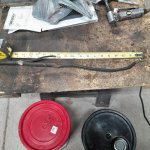- Joined
- Mar 6, 2020
- Messages
- 1,860
- City
- 48022
- State - Country
- MI - USA
- Vehicle Year
- 1994
- Vehicle
- Ford Ranger
- Engine
- 4.0 V6
- Transmission
- Automatic
- Total Lift
- 1-1/2 inch front leveling
- Total Drop
- Stock
- Tire Size
- 31/10.50/15
- My credo
- What's the worst that could happen?
On my neg cable, about 17 inches from the starter end, there is A T/O. In the evtm it shows the TO going to the engine ( I think...don't have it in front of me).
When I removed the existing cable, that TO used to have some sort of connector _ totally corroded and disconnected from where it's supposed to go.

1. Does anyone know where it connects to?
2. Should I recreate.this ground connector on the new cable?
It just seems like a bad idea. It was taped up and coverrd at one-time but after30 years, not so much. Lots or corrosion build up.
Thanks
When I removed the existing cable, that TO used to have some sort of connector _ totally corroded and disconnected from where it's supposed to go.

1. Does anyone know where it connects to?
2. Should I recreate.this ground connector on the new cable?
It just seems like a bad idea. It was taped up and coverrd at one-time but after30 years, not so much. Lots or corrosion build up.
Thanks
Last edited:













